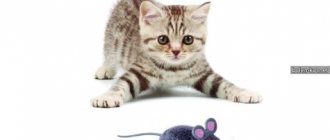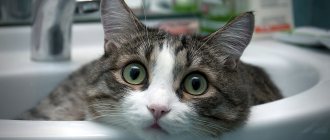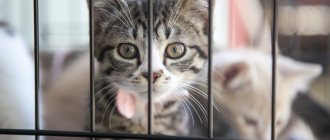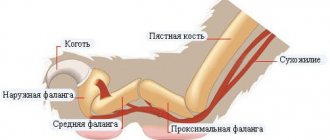Advantages and disadvantages of leashes
Pros:
- Carrying out walks, knowing that the animal will not run away;
- Control over your pet, the ability to avoid hard-to-reach or dangerous places, exclusion of unwanted situations (meeting stray dogs and cats);
- The risk of losing an animal is significantly reduced. He is constantly in sight, which will prevent him from eating anything on the street, jumping into garbage cans, and so on;
- Adjusting the distance between the owner and the pet;
- Just for the peace of mind of the owner himself.
Minuses:
- Not all cats quickly get used to leashes. They may panic, try to break free and run away, and in an agitated and nervous state, the cat may harm itself;
- Incorrectly chosen leashes injure animals, severely squeezing the neck;
- Poor quality leashes can break at any time, and it is possible that the cat, taking advantage of this, will run away and get lost.
Contraindications and restrictions for walking
Walking is not recommended for some cats, even if they are already leash trained.
The prohibition applies to:
- unvaccinated kittens aged 3-6 months due to the fact that the maternal immunity received with colostrum in the first hours of life has ceased to act, and its own has not yet been fully formed;
- nervous, timid animals with an excitable psyche, whose behavior outside the home is unpredictable;
- cats during periods of estrus, pregnancy and lactation;
- pets who have recently suffered from illness or surgery;
- for older cats who have never been outside, a walk can become a stress factor for them.
Animals that have undergone primary vaccination, in the absence of other contraindications, can be released outside no earlier than two weeks from the date of vaccination.
When not to use a harness
- Walking an old cat that is not leash-trained can be a stressful situation for her, which will negatively affect her health;
- A harness for walking a small kitten requires careful selection due to its rapid growth;
Harnesses are not recommended for pregnant cats, or after surgical procedures, or for cats with physiological defects.
Differences between cats and dogs
If you have a sociable animal that accepts most new things, then you can certainly try walking with your pet. But if you have a cat that hides under the bed even at the slightest change in the home environment, experts don't recommend adding stress to the cat.
Cats readily accept indoor play as their only place to relax, and their social tendencies vary greatly: meeting unfamiliar cats is often stressful for the animal rather than an opportunity to play and socialize with others. Walking means moving in an unknown environment without the usual smells. There is also a risk of the cat being injured or suddenly frightened when encountering unfamiliar dogs.
Purpose of collars
Collars are purchased in particular for anti-parasitic purposes, as well as in case the animal gets lost or something happens to it. A medallion is attached indicating the cat's name, owner's phone number or address.
Stress
All cats experience negative experiences on their first walks. This is fine. If you sat inside four walls all your life and didn’t know that there was a world around you, you would be scared too. In addition, cats have a heightened sense of hearing and smell, and therefore new sounds and smells of the street seem stronger to them than to us, which is also frightening and stressful at first. But over time, everything changes - and the cat, who hated the street, suddenly begins to love it, because he understands: it’s interesting, it smells nice, it gives new vivid impressions.
With the right approach, which starts with taking the cat in a carrier or in a special space backpack out into the yard for 5 minutes, almost any animal can be taught to love walks. To do this you will need from 1 to 10 outputs. But there always remains a small percentage of those who are against it, even despite regular appearances. It’s probably better to leave them at home and not force them: if the animal experiences negative stress every time during a walk, this will not bring anything good - then let it breathe the air while sitting on the windowsill.
Types of harnesses
The essence of cat leashes is to attach the leash to straps that go around the cat's body, which allows you to do without a collar.
They differ in mounting methods:
- Eights. They consist of a pair of loops that are attached to the neck and front legs;
- Vests (jackets). Simple clothes with a leash. Used more often in cool weather. They are made from various materials and decorated in different ways.
- H-shaped. Similar to the figure eight, only the loops on the back are connected using a cross bar.
- V-shaped. The loop in the pet’s chest area looks like the letter “V”, but there are no fundamental differences.
- Y-shaped. Accordingly, the loops are in the shape of the letter “Y”.
Cats hate any embarrassment!
Of course they hate it!
They hate a lot of what life next to a person forces them to do. But still not so much as not to put up with it for the sake of the benefits that coexistence brings them. For example, delicious food. Did you guess it? Walking on a leash is an element of training, and correct behavior must be rewarded. Praise your cat for her calm and indifferent attitude towards the harness and leash, give her treats, and rejoice in her successes. And when she truly feels the joy of walking, she will love her leash and will express impatience when it is in your hands.
Recommendations for choosing leashes and harnesses
There are two types of leashes: a belt of a given length and a tape measure. The specified length is determined by the activity of the animal. It is used in cases where the pet is timid and when walking in familiar places.
Roulettes are great for walking freedom-loving animals, and the owners themselves will not follow them around, adjusting the required length.
When choosing a leash, you need to take into account its quality (it should not tear), not consisting of a very dense and hard material (the most popular is natural, artificial leather or tarpaulin with different decor and color); the optimal length is 2-2.5 m.
When buying a harness, it would be ideal to take your pet with you, but if this is not possible, you should consider the following nuances:
- Dense, but not rough material, easy to wipe off (nylon, does not rub and fits well to the cat’s body; cotton for older animals with little activity, and for the delicate and sensitive skin of pets, a felt or fleece lining is suitable). Do not use leather products due to heavy weight, chafing and inconvenience to use.
- The width of the straps should ideally be one and a half centimeters, since wider widths will restrict the cat’s movements, and narrow ones usually rub and tighten.
- Fastenings should be easy to fasten and unfasten to ensure durability and high quality to prevent them from breaking.
- The presence of a mechanism for attaching to a leash.
When purchasing a harness without a pet, it is advisable to take his measurements in advance.
If purchased together with a “mustachioed” one, you need to try on the models you like. You can determine whether it fits or not by inserting two fingers between the back of the animal and the strap. When the fingers pass freely, it becomes clear that this model has been chosen correctly.
There are models specially made to make the cat look stylish and beautiful (the presence of rhinestones, pendants, ornaments). Here you need to be careful, as they are more suitable for performing animals in front of the public, participating in exhibitions, and not for ordinary walks, where they can only create inconvenience.
This is interesting
Many cats love to walk so much that their owners manage to take them with them even to the sea or to the mountains. The cat named Paul has already visited many places with his owners, and recently conquered Mount Grays Peak, 4350 m high.
The McMillen family captures all the adventures of the gallant and brave cat and posts the photographs on the Internet. The cat is not afraid of living creatures, swims with pleasure and can withstand long walks.
Correctly putting a leash on a cat
Walking pets without a leash or identifying marks is a very irresponsible act and unsafe for them. But not every lover of these creatures knows exactly how to put a leash on a cat.
First, the cat is calmed down by caressing and saying friendly words, and allowed to smell the walking device. Dressing itself should be calm so as not to frighten the pet.
Then the harness is put on, throwing one of its loops with a carabiner up, and putting the cat’s paws into the other, followed by adjusting the straps until they fit snugly, but not tightly, around her body.
Lastly, fasten the leash to the ring and check that all fastenings are secure.
When should a cat be walked?
Walking your cat is good for its health. Animals walking outdoors are rarely obese. They are more resilient. In addition, an appropriate lifestyle will help preserve the natural instincts of your furry pet. Walking will diversify their usual measured life. But only a healthy cat can be taken out of the house.
Walking can be with the owner or free. In the second case, the pets walk and return to the house on their own. This is how their life goes on at their summer cottage or in the village.
But in the city, animals cannot be released unattended. There is heavy traffic and large crowds of people. The cat may get scared. Therefore, it is safer to walk her accompanied by her owner. But keeping your pet on a leash can also cause stress. Cats perceive it as a limiter on their freedom. In times of danger, the furry animal cannot run or hide. And this makes him nervous.
For a domestic cat living in an apartment, the street is always a big risk. Therefore, only the owner can decide whether his pet will go for walks. There is no clear answer to this question.
Leash training a cat
You need to get used to it gradually, first by walking the cat on a leash at home. Observe her reaction, take your time and give her time to get used to the leash. To do this, for example, they leave it in the pet’s favorite places.
The next step is to put on the harness. Having tried to do this, look at the behavior of the animal (aggressive or overly frightened), then you need to postpone the attempts and repeat them later again.
- The most suitable age to begin the adjustment period is from 3 months to 1 year.
- The older the animal is, the more difficult and slower the addiction will be.
How to train a cat to wear a harness
The safest way to walk a cat is to put a harness and leash on it. But everything is not as simple as it seems at first glance. The animal still needs to be accustomed to the collar. The fact is that felines cannot stand it when foreign objects are leaned against their body.
After purchasing a harness, you need to give it to your pet, let him smell it and play with it. A few days before the walk, you need to try on the harness. If your pet stands up straight, then you can go for a walk with him even the next day. However, most animals begin to spin around, trying in vain to get rid of their bonds. What to do and how to accustom a cat to a leash in this case?
In fact, everything is extremely simple. The main thing is not to give up and put the harness on the cat for a short time every day. Over time, the pet will become accustomed to the new clothes, and they will no longer bother him; subsequently, they can easily be put on before walking the animal outside.
Rules for the first walk
On the first walk down the street, it is recommended to pick up the cat and carry it to a quiet, secluded place where there are no people, dogs and cats, and then let it land. Perhaps the cat will not move for some time, carefully examining everything around it.
There is no need to rush her, let her decide for herself when to move on. At the same time, it is necessary to provide conditions where nothing will scare the animal, otherwise the pet will not want to go outside for a long time.
Petersburg woman with a cat on a leash, explain: why walk the animal, he’s scared!
Why walk a domestic cat, what scares him more: dogs or noise on the street, why does the animal need a leash, and are such walks really good for the cat? Maine Coon owner Anastasia Kovaleva explains how and why she walks her pet in St. Petersburg.
Photo from the archive of Anastasia Kovaleva
When did you start walking your cat?
My husband and I have wanted to have a pet for a long time. At first we thought about a dog, but since we study and work, there would be no time left for such a pet. Then they decided to get a cat - a more independent animal.
My husband jokingly suggested getting a “cat with a dog’s character.” And this joke went on so long that we actually adopted a Maine Coon - a wild domesticated cat, which already, at seven months old, can be compared in size to an average dog.
We decided that the wild cat needed wild nature, so we started taking her outside from the first months. At first, Alpha (that’s the cat’s name) was very afraid of street noises: she pressed herself to the ground and crawled to a secluded place. We are still teaching her to take such walks.
Why are you walking your cat in the city?
We live in St. Petersburg, that’s why we walk with her here.
Because of the always bad weather, Alpha and I don’t go for walks much. I don’t want to take her outside where there is slush, rain, frost and wind. We walk mostly in warm weather. It’s also possible to go out in winter, since Maine Coons are adapted to the cold, but she doesn’t particularly like the snow.
Now we are vacationing in Crimea. When they brought Alpha to the sea, she didn’t really like it either. According to the veterinarian and our observations, she is absolutely comfortable walking only in the forest.
Photo from the archive of Anastasia Kovaleva
How do passers-by and other animals react to a cat with a leash?
When we decided to walk Alpha on the street, we told our relatives and friends about it. Everyone reacted to this absolutely normally, because they understood: the cat is big and needs to move a lot. They knew that we consulted the veterinarian on everything.
Only passers-by were surprised. People still come up and ask why all this. Some people say they tried walking their cats but it didn't work out. Very often we are asked if this is really a Maine Coon.
Alpha herself is not very fond of passers-by and dogs. When she first met the Labrador, she automatically rose on her hind legs, her eyes bulged, and her fur stood on end. The dog got scared and left. She tries to avoid passers-by.
Five myths about walking cats on a leash
1.
Walking cats is harmful
We consulted with a veterinarian and found that walking cats can only be dangerous if it causes them stress. And Maine Coons, they are wild, they need it: more space outside, fresh air. Now Alpha goes outside on her own and explores the territory.
2.
Maine Coons are dangerous for children and small dogs
I have never encountered a Maine Coon harming anyone. Our Alpha, if she doesn’t like something, just takes it and leaves; she is peaceful, loving.
3.
You can also cuddle a cat outside
Alphas don't really like strangers. When someone approaches her that she doesn't know, she feels threatened. These are the situations that can cause her stress.
4.
You can walk your cat anywhere
I think it's different for each cat. Again, the main thing is not to let her experience stress. Now we have come to the conclusion that we do not take Alpha out into the courtyards, but only walk with her in parks and forests.
5.
A cat doesn't need a leash
Of course, you need a leash. A cat, like any other animal, can run away if it gets scared of something.
What challenges are you facing?
The only problem is the noise on the street. The cat becomes uncomfortable, this is unusual for her. Something might scare her on the street, and after that she will cower and lose her appetite. It works like a human: in such situations she needs to run away to a secluded place.
Making a leash at home
You can do without buying it in a store by making your own cat leash at home using a long strip of thick fabric, scissors and a ring with a carabiner.
- A strip of fabric is folded in half lengthwise, stitched with thick thread, and the cut ends are folded over, securing them securely.
- Then a palm loop is made at one end, and a ring with a carabiner is firmly secured at the other.
Here is one way to make a leash for a cat without resorting to buying it in stores.
Which pets are not recommended for walking?
There are animals that are prohibited from being taken outside. For such cats and their owners, walking can become a big problem.
It is not recommended to walk animals in the following cases:
- Kittens up to 5 months. They have a very weak immune system, and on the street you can catch a virus or accidentally get injured.
- Impressionable, aggressive, timid animals. They pose a danger to others. A sudden movement or cry leads to aggressive actions by the animal. The cat may attack the owner or a stranger, get scared or run away.
- During heat, cats gather all the cats near them. If pet owners do not need such problems, it is not advisable to walk their pet at this time.
- Without a flea collar or vaccinations, your cat may become infected with something and pick up insects. Treatment is not cheap, so it is not worth the risk.
- Walking is not recommended for a long-term pregnant cat. If your pet has never walked outside, you should not go there during this period.
- Sick animals who have recently been ill or have undergone surgery need to stay at home.
Photos of the best leashes for cats
What to consider when buying a harness
The first thing to consider when purchasing is the material from which the harness is made. Your cat may not like a heavy, stiff leash. She will try to throw off the burden.
In order not to limit freedom of movement, it is better to choose a long leash (two meters or more). It is most convenient to use an adjustable leash-roulette.
Alternative methods
If the above tips did not help and your cat constantly asks to go outside, try making the front door an unpleasant, perhaps even frightening place for your pet.
As soon as the cat approaches the front door, begins to meow heart-rendingly, asking for a walk, or sits, waiting for an opportunity to escape, try to scare the animal. Spray a stream of water from a spray bottle, clap your hands, shout at the cat or shake a metal can of coins, throw in the keys. Cats are afraid and do not like sharp rustling, whistling, rustling sounds. As soon as the cat leaves the door, caress, praise the mustachioed pet, and give him his favorite treat. Special sprays, aerosols with repellent aromas, citrus peels placed near the threshold, and containers with essential oils will help keep cats away from the front door.
But if you see that your pet is still sad and needs freedom, from time to time take him for a walk, but only on a special harness. Walk your cat in secluded, quiet places. You can place the cat in a special spacious enclosure or a cage for transportation, arranging its space properly.
The cat continues to ask to go outside, and, as a rule, this behavior worsens during the period of sexual heat (spring, autumn), in this case, special means that reduce sexual desire, which the veterinarian will prescribe, will help. But do not forget that long-term use of such drugs provokes hormonal imbalance and leads to the development of systemic failures in the body. Therefore, if the animal is not of breeding value, you do not plan to adopt a pet; castration and sterilization will help wean the cat off from walking.
In any case, whether or not to wean your cat from the street is entirely your decision. But do not forget that, despite all the attractiveness of freedom, it is on the street, especially in large cities, that a lot of dangers await pets, ranging from banal injuries, bruises to serious infections and diseases.
Stage 4. Choose a place and time for a walk
The first walk should be carefully thought out by the owner:
- Place . A cat that has never been outside its familiar environment will most likely become frightened and protest. Therefore, you should carefully choose your walking route. There should be no dogs, street cats, or crowds of people nearby. We choose a calm, quiet place, away from the noise of cars. There should be no dense bushes or tall trees nearby. Otherwise, you will have to pull your pet out of the bushes or climb trees after it (read more about how to remove a cat from a tree).
- Habituation and familiarization . You need to wait until the cat himself expresses a desire to come down to the ground. Planting it in tall grass will make the cat feel more protected. Stroke the pet, talk, encourage. The cat will sit in one place for a long time. Don't be nervous - he needs time to get comfortable, sniff everything, and calm down. As soon as the cat calms down, he will begin to choose his own route for a walk. If the owner does not like following the pet along the “cat path,” he needs to stop. Do not pull the leash, do not scold the cat and do not get nervous. Sooner or later, the animal will get tired of trying to redirect the person, and it will go in the right direction.
- Time . If there are no such quiet places near your home, then you can choose a convenient time - in the morning or in the evening.
A walk should be enjoyable for both the owner and the furry pet.
About ½ of domestic cats do not enjoy walking on a leash.
In this case, you need to come to terms with it. Such a “homebody” may well have enough impressions and fresh air through an open and screened window.
Also watch the video on how to teach a cat to walk on a leash:
Proper feeding of your pet
Many cat owners prefer ready-made food. These products provide balanced, high-quality nutrition. But if it is not budget category food containing harmful substances that lead to liver and kidney diseases
It is important to choose products that are appropriate for the age of the animal. For owners who do not have the opportunity to regularly purchase ready-made “extra” class food, it is better to feed the kitten with natural products, ensuring an optimal supply of all necessary microelements
It is understandable to want from the heart to feed a hungry homeless animal. But you need to understand that street life does not contribute to the proper digestion process. Most likely, the system functions are impaired. At first, the cat needs to be fed dietary food. Volumes should be reduced, overeating during the period of getting used to homemade food is unacceptable.
Proper feeding will allow the body to adapt to a new diet without stress and will avoid stool disturbances and diarrhea, which can lead to dehydration.
Wild mice
If the cat is not free-ranging, but follows you on a leash and, moreover, sits in your arms, there is no point in worrying that it will eat a mouse, rat or bird: you simply will not allow it. And you will do the right thing, because... wild rodents can be infected with rabies and other infections.
Yes, most cats that have free access to the outdoors are alive and well, despite eating mice and birds. But it’s still better to be careful. If you want to feed your cat mice, you can buy special laboratory mice for it.
Pros and cons of being outside
Solo street walks have many advantages and disadvantages. Such a pastime has the following advantages:
Tips for new residents on how to properly introduce their beloved cat into a new apartment
- Staying in the fresh air has a beneficial effect on the health of the animal. The cat has many opportunities for physical development: he will run a lot, jump, climb trees and walk along fences. All this is especially useful for pets prone to weight gain.
- An inquisitive representative of the cat tribe on the street receives many new impressions. This improves his mood and increases vitality.
- On the street, the cat follows its natural instincts: sharpens its claws, hunts, runs and tumbles. In a secluded place, he can make a nest for himself, where he will hide and observe the world around him.
- If a cat walks outside, the life of the owners will become more comfortable. A four-legged friend will be less likely to tear furniture and curtains with his claws, as well as mark surrounding objects.
At the same time, street walks are fraught with many dangers for your pet. The following threats exist:
- The most serious danger to cats is cars. Animals are threatened not only by busy city highways, but also by quiet country roads, where a cat may be frightened by a suddenly appearing car. Animals often hide under cars, and when the car moves sharply, the animal may not have time to jump out from under the wheels.
- An inquisitive pet may wander too far from its place of residence and get lost. Sometimes cats get into someone else's garage or utility room, where they can be accidentally locked.
- A walking pet is threatened by dogs, foxes, and aggressive brothers.
- As a result of interaction or fights with other animals, especially stray animals, a domestic cat can become infected with various diseases. These are viral infections, fungal diseases and much more.
- Pets often pick up fleas, ticks and other ectoparasites on the street. There is also a high risk of helminth infection.
- The animal may eat poisonous bait, a sick or poisoned rodent. It can be poisoned by antifreeze, garden pest control, or rat poison.
- A domestic cat whose natural instincts are weakened may also eat a dangerous poisonous plant, such as a lily or poinsettia.
Ancient ancestors of cats and what they looked like
Infections
One of the arguments against walking cats in the article I mentioned above was the fact that outdoors a cat can encounter fungi, in particular Histoplasma capsulatum. It is a soil fungus that forms mycelium in the environment and transforms into a yeast form in the host. Infection occurs through inhalation of dust.
Sounds scary. But a smart owner, when told such horror stories, will definitely make inquiries and find out that this fungus can infect not only animals, but also people. Therefore, logically, everyone, not just cats, needs to stay at home to be afraid of it. But we are not sitting. So why should cats?
In addition, this kind of fungi is part of the world around us and affects only weakened mammals. You encounter these and other fungi literally everywhere, but have any of you or anyone you know gotten sick? Such cases are rare. And all because our immune system does not sleep: for a healthy body, such fungi, like most bacteria, are nonsense. Even the fungi that cause ringworm are mainly dangerous only for children and small kittens: adult animals and people easily crush these fungi with their immunity.
Article continues after advertisement
But the factor of dangerous infections is worth taking into account and you need to prepare for it. However, it is not fungi that need to be feared most of all, but primarily panleukopenia (distemper), calicivirus infection and rabies. These are, indeed, dangerous infections, and therefore domestic cats that do not have vaccinations do not need to walk outside. In addition, they should not have contact with other animals that do not live in your family.
Unvaccinated pets have every chance of getting sick, even while at home. The same plague virus can be brought home on shoes along with particles of dirt. In general, vaccinations are needed in any case.
In addition, even if a vaccinated cat is currently weakened, for example, she has recently been ill with something, is pregnant or nursing kittens, and is also in heat, there is no need to take her outside yet.











